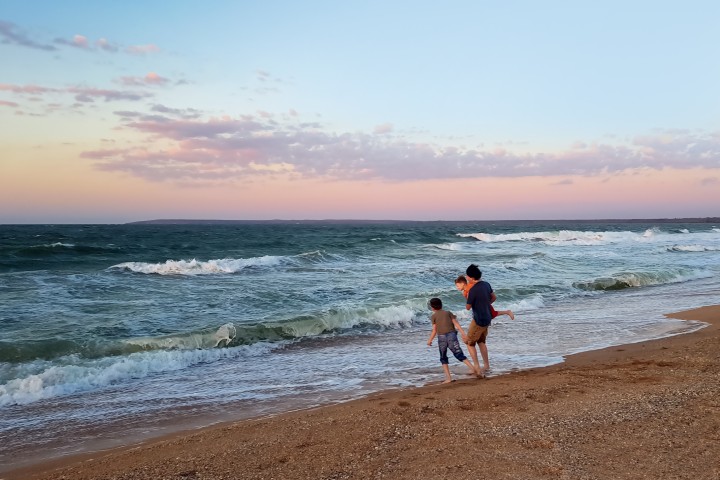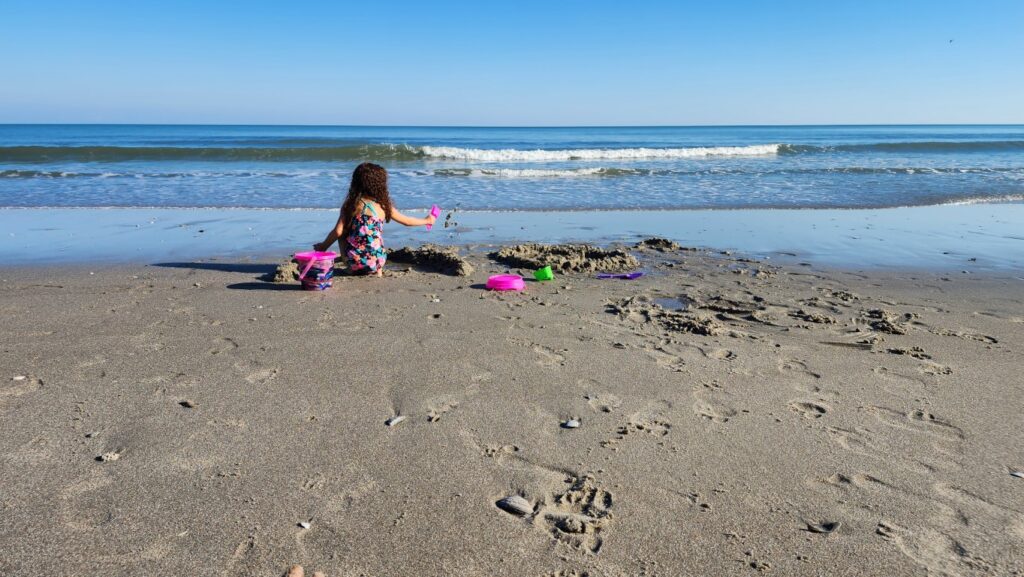Hitting the beach is all about good vibes, but keeping safety in mind ensures those good times roll without a hitch. It’s not just about sunscreen and flip-flops. Understanding the basics of beach safety is key to enjoying your day.
First off, knowing why beach safety is a big deal can save you loads of trouble. Beaches are dynamic environments with variables like tides, currents, and wildlife. Each element requires respect and awareness for things to stay fun and safe.
1. Stay Alert At All Times

Being aware of your surroundings is rule number one. Take a minute to get the lay of the land.
- Look out for any flags on the beach
- Check local weather reports
- Keep tabs on the times of high and low tides.
It’s about planning and preparation.
2. Know The Beach Layout
Another tip is understanding the beach’s topography. Each beach has its own unique features. Some might have steep drop-offs close to the shore while others might have sandbars further out.
A good example of this are the beaches surrounding Bermuda, the island where I was born and raised. Many of them suddenly drop off since Bermuda basically sits on a large underwater shelf.
Knowing this helps you avoid potential hazards before setting foot in the water.
3. Preparing for a Safe Beach Outing
Getting ready for a beach day requires more than just picking a bikini or swim trunks. Packing smart can make all the difference when it comes to safety.
Always include essentials like:
- sunscreen
- hats
- sunglasses
- plenty of water
This way you can help keep everyone hydrated and protected from the sun.
4. Dress for the Occassion
What you wear can play a big role in safety. Choose swim attire that’s comfortable and functional.
Rash guards provide extra protection against the sun and are a great choice for kids spending lots of time in the water. Footwear like water shoes can prevent injuries from sharp shells or hot sand.
Before you head out, it’s good to do a quick check on the weather and ocean conditions. Technology makes this super easy with weather apps or websites giving you the lowdown on temperature, wind speeds, and tide times.
Rough seas or unexpected storms can be dangerous, so if the forecast looks dodgy, consider rescheduling your trip.
5. In Water: Keeping Kids Safe in the Ocean

When it comes to kids and water, vigilance is your best friend. It’s all about keeping them within reach and under close surveillance. No matter how calm the ocean appears, children should never be left unsupervised while swimming.
Life vests (not just inflatable water wings) are a smart pick for young swimmers and those who are not strong swimmers. They offer reliable buoyancy and are a trusted safety measure when the little ones venture further out. Make sure to select one that’s well-fitted and Coast Guard approved for peace of mind.
Teaching kids about ocean safety is also crucial. There’s no better time than now to make them aware of the basics like identifying rip currents, recognizing the warning flags, and understanding the depth changes.
A few simple lessons can arm them with knowledge that could be lifesaving.
6. How to Keep Your Family Safe at the Beach
Picking a prime spot on the beach is more strategic than just grabbing the nearest patch of sand. Look for a spot within sight of a lifeguard tower. It’s a simple step that can add an extra layer of security to your day.
A buddy system isn’t just for kids. Everyone should have a beach buddy. This means having someone to look out for you, whether you’re in the water or relaxing on the shore. It’s all about watching each other’s backs.
7. Know The Beach Flag System
The beach flag system is like a secret code for safety. Learning to identify these flags can tell you everything you need to know about current conditions, from water quality to the presence of dangerous marine animals. Before lounging, peek at the flags and know what they mean.
Stay mindful of the distance from your chosen spot to the water’s edge and the path to amenities like restrooms or concessions. This helps in case of a quick need for refreshment or a hurried escape from incoming tides.
8. Essential Beach Safety Rules You Must Follow
Before you stretch out on the sand, knowing the beach safety rules can keep things smooth like the perfect wave. Every beach has its own set of guidelines, and getting familiar with these makes all the difference.
It’s not just about following the rules but understanding why they’re there in the first place.
Rip currents are one of those things you hope to avoid but need to know about nonetheless. These powerful, narrow channels of water can sweep even stronger swimmers out to sea. If you ever find yourself caught in one, the key is not to panic. Instead, swim parallel to the shore until you’re out of the current’s grip.
9. Marine Etiquette
Get clued up with the beach’s marine life etiquette. Keep your distance from creatures like jellyfish or crabs. Sometimes they wash up, and while the curious might find it tempting to poke or prod, it’s safer and kinder to let them be. Respecting these animals is crucial, not just for your safety but for theirs as well.
Each beach might have specific rules posted regarding what materials or activities are permitted. Following these rules helps keep the beach clean and safe for everyone, from limiting glass containers to inflatable toys.
10. Don’t Underestimate Beach Safety
Teaching kids about proper beach etiquette doesn’t just help them enjoy the ocean more, it also keeps them safe. Encourage them to respect lifeguards and follow instructions on beach signage. Knowing how to share the space with other beachgoers is part of the fun.
In case of emergencies, preparation is everything. Familiarize yourself with the location of the nearest first aid station or lifeguard tower. A charged phone for emergency calls is a smart choice too. Quick access to these resources can make a crucial difference.
Choosing child-friendly beaches can enhance safety and fun. Look for those specifically noted for calm waters, lifeguard presence, or family facilities like restrooms and showers. They make the outing enjoyable without compromising on safety.
This is such a comprehensive guide to beach safety! I appreciate how you’ve broken down everything from understanding rip currents to choosing the right beachwear. It’s a reminder that a safe beach day requires more than just packing sunscreen. The tip about teaching kids to identify rip currents and understand the beach flag system really stood out to me, it’s empowering and practical. This article makes me feel much more prepared for my next family beach outing. Great work!
Hey Kavitha,
Thank you so much for your kind words! It means a lot to know that the guide resonated with you and that you feel more prepared for your next family beach outing. Empowering families, especially kids, to understand beach safety is one of the most important steps to enjoying a carefree day by the water.
Teaching kids about rip currents and the beach flag system not only builds their confidence but also gives parents peace of mind. It’s wonderful to hear that this tip stood out to you. It really can make a big difference.
Wishing you and your family a fun and safe time on your next beach adventure! If you have any more questions or need tips for your trip, feel free to reach out. 🌊☀️
Staying safe at the beach is indeed much more than just grabbing swimwear and sunscreen. Knowing if it is a safe beach for swimming, requires some research into the local conditions, specially if you are a holiday maker and not familiar with the local beach.
Looking out for rips in the water, is something that is essential if you do not want to be washed out to see. But what do you do if you do get caught in a rip tide? Do you have tips on how to identify a rip tide?
Thank you for sharing.
Thank you for highlighting such an important aspect of beach safety! You’re absolutely right! Choosing a safe beach and understanding local conditions are key, especially for holidaymakers unfamiliar with the area.
To identify a rip current, look for:
Darker patches of water where sand is being pulled out to sea.Rippled surfaces or choppy waves in an otherwise calm area.Foamy, sandy water flowing away from the beach, often beyond the breaking waves.
If you ever get caught in a rip current, here’s what to do:
Stay calm: panicking will exhaust you faster.Float or tread water to conserve energy and avoid fighting the current.Signal for help by raising one arm if you’re struggling to escape.Swim parallel to the shore to break free from the rip; once you’re out, head back to shore at an angle.
And, of course, always swim at beaches with lifeguards when possible, as they can provide guidance on safer swimming zones.
I hope these tips help! Let me know if you’d like more resources or details. Staying informed is the first step to enjoying the beach safely. 🌊